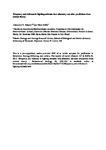Weaponry and defenses in fighting animals: how allometry can alter predictions from contest theory
| dc.contributor.author | Palaoro, AV | |
| dc.contributor.author | Briffa, Mark | |
| dc.date.accessioned | 2017-01-31T17:49:22Z | |
| dc.date.available | 2017-01-31T17:49:22Z | |
| dc.date.issued | 2016-11-30 | |
| dc.identifier.issn | 1045-2249 | |
| dc.identifier.issn | 1465-7279 | |
| dc.identifier.uri | http://hdl.handle.net/10026.1/8339 | |
| dc.description.abstract |
Theoretical models have been developed to understand how animals decide to withdraw from a contest. They provide testable predictions regarding the relationship between resource holding potential (RHP) and contest duration that assume linear relationships among RHP traits. However, RHP traits might scale with body size according to power laws. Furthermore, investment across different RHP traits may vary. Herein, we provide a model that encompasses the allometric relationship between body size and other RHP traits. First, we partition RHP traits into "offensive" traits (i.e., the ability to inflict damage) and "defensive" traits (i.e., persistence in a contest). Defensive traits may in turn be subdivided into "damage endurance" (DE) or the ability to absorb damage and "stamina." We then model scenarios where: 1) there are power relationships among RHP traits; 2) individuals invest differently in defensive and offensive traits; 3) offensive traits and DE have a positive/negative relationship with body size. We modeled sized-matched injurious contests where 1) offensive capacity (OC) increases superlinearly with body size, 2) DE increases superlinearly, and 3) OC increases superlinearly but DE increases sublinearly. Our analyses indicate that if RHP traits scale linearly current predictions are upheld for injurious contests - contest duration increases with body size. However, with power relationships we can expect nonlinear relationships. Here, contest duration increased with body size until a maximum, decreasing afterwards. Thus, considering allometric relationships between body size and RHP traits may lead to new insights in animal contest theory and may help to solve discrepancies between current theory and empirical data. | |
| dc.format.extent | 328-336 | |
| dc.language | en | |
| dc.language.iso | en | |
| dc.publisher | Oxford University Press (OUP) | |
| dc.subject | assessment models | |
| dc.subject | agonistic behavior | |
| dc.subject | resource holding potential | |
| dc.subject | contest duration | |
| dc.subject | allometric scaling | |
| dc.title | Weaponry and defenses in fighting animals: how allometry can alter predictions from contest theory | |
| dc.type | journal-article | |
| dc.type | Journal Article | |
| plymouth.author-url | https://www.webofscience.com/api/gateway?GWVersion=2&SrcApp=PARTNER_APP&SrcAuth=LinksAMR&KeyUT=WOS:000397065500038&DestLinkType=FullRecord&DestApp=ALL_WOS&UsrCustomerID=11bb513d99f797142bcfeffcc58ea008 | |
| plymouth.issue | 1 | |
| plymouth.volume | 28 | |
| plymouth.publication-status | Published | |
| plymouth.journal | Behavioral Ecology | |
| dc.identifier.doi | 10.1093/beheco/arw163 | |
| plymouth.organisational-group | /Plymouth | |
| plymouth.organisational-group | /Plymouth/Faculty of Science and Engineering | |
| plymouth.organisational-group | /Plymouth/Faculty of Science and Engineering/School of Biological and Marine Sciences | |
| plymouth.organisational-group | /Plymouth/REF 2021 Researchers by UoA | |
| plymouth.organisational-group | /Plymouth/REF 2021 Researchers by UoA/UoA04 Psychology, Psychiatry and Neuroscience | |
| plymouth.organisational-group | /Plymouth/Research Groups | |
| plymouth.organisational-group | /Plymouth/Research Groups/Marine Institute | |
| plymouth.organisational-group | /Plymouth/Users by role | |
| plymouth.organisational-group | /Plymouth/Users by role/Academics | |
| plymouth.organisational-group | /Plymouth/Users by role/Researchers in ResearchFish submission | |
| dcterms.dateAccepted | 2016-10-21 | |
| dc.rights.embargodate | 2017-11-30 | |
| dc.identifier.eissn | 1465-7279 | |
| dc.rights.embargoperiod | 12 months | |
| rioxxterms.versionofrecord | 10.1093/beheco/arw163 | |
| rioxxterms.licenseref.uri | http://www.rioxx.net/licenses/under-embargo-all-rights-reserved | |
| rioxxterms.licenseref.startdate | 2016-11-30 | |
| rioxxterms.type | Journal Article/Review |


